Fritz Lang (1890-1976) was an Austrian-German-American filmmaker, screenwriter, and occasional film producer and actor. One of the best-known émigrés from Germany's school of Expressionism, he was dubbed the "Master of Darkness" by the British Film Institute. Lang's most famous films include the groundbreaking futuristic Metropolis (1927) and the influential M (1931), a Film Noir precursor that he made before he moved to the United States. His other notable films include Dr. Mabuse, der Spieler/Dr. Mabuse the Gambler (1922), Die Nibelungen (1924), Fury (1936), You Only Live Once (1937), Hangmen Also Die! (1943), The Woman in the Window (1944), and The Big Heat (1953).

American postcard by Fotofolio, New York, N.Y., no. P124. Photo: Ufa / The Mansell Collection.

German photocard for the album Vom Werden deutscher Filmkunst. Teil I. Der stumme Film by Ross Verlag, picture no. 63. Photo: Decla-Film. Lil Dagover and Carl de Vogt in Die Spinnen/The Spiders (Fritz Lang, 1919-1920).
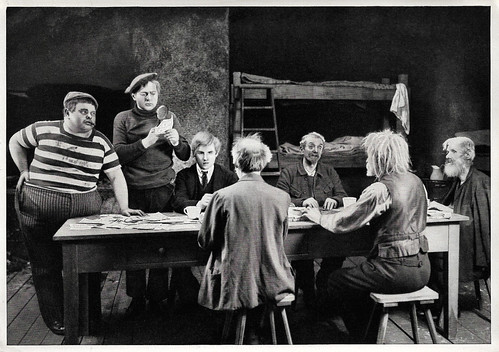
German collectors card by Ross Verlag in the series Vom Werden Deutscher Filmkunst - Der Stumme Film, picture no. 94, group 40. Photo: Ufa. Publicity still with Károly Huszár (left) and Rudolf Klein-Rogge (second from left) in Dr. Mabuse, der Spieler/Dr. Mabuse, King of Crime (Fritz Lang, 1922). Caption: Dr. Mabuse, who prints false money, lets the false notes sort by blind people who can not betray him.

German collectors card by Ross Verlag in the series Vom Werden Deutscher Filmkunst - Der Stumme Film, picture no. 143, group 43. Photo: Ufa. Heinrich George and Brigitte Helm in Metropolis (1926). Heinrich George plays the scene".

German collectors card by Ross Verlag in the series Vom Werden deutscher Filmkunst - Der Stumme Film, picture no. 124. Photo: Ufa. Rudolf Klein-Rogge and Gerda Maurus in Spione/Spies (Fritz Lang, 1928).

German collectors card by Ross Verlag in the series Vom Werden Deutscher Filmkunst - Der Stumme Film, picture no, 173, group 43. Photo: Ufa. Willy Fritsch in Spione/Spies (Fritz Lang, 1928).
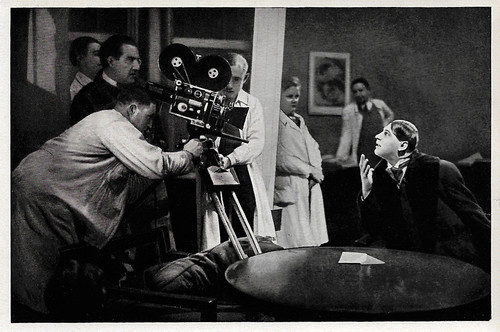
German collectors card by Ross Verlag in the series Vom Werden Deutscher Filmkunst - Der Stumme Film, no. 169, Group 43. Photo: Ufa. Fritz Lang and Fritz Rasp at the set of Frau im Mond/Woman in the Moon (Fritz Lang, 1929).

German collectors card by Ross Verlag in the series Vom Werden Deutscher Filmkunst - Der Stumme Film, picture no. 138, group 40. Photo: Ufa. Willy Fritsch, Gerda Maurus and Gustl Stark-Gstettenbauer in Frau im Mond/Woman in the Moon (Fritz Lang, 1929).
Friedrich Christian Anton 'Fritz' Lang was born in Vienna, Austria-Hungary (now Austria), as the second son of Anton Lang, an architect and construction company manager, and his wife Paula Lang born Schlesinger.
Paula was Jewish but converted to Catholicism when Lang was ten. His parents took their religion seriously and were dedicated to raising Fritz as a Catholic. Lang frequently had Catholic-influenced themes in his films.
After finishing school, Lang briefly attended the Technical University of Vienna, where he studied civil engineering and eventually switched to art. He left Vienna in 1910 in order to see the world, traveling throughout Europe and Africa, and later Asia and the Pacific area. In 1913, he studied painting in Paris.
At the outbreak of World War I, Lang returned to Vienna and volunteered for military service in the Austrian army. He fought in Russia and Romania, where he was wounded four times and lost sight in his right eye.
While recovering from his injuries and shell shock in 1916, he wrote some scenarios and ideas for films. These were filmed as Die Peitsche/The Whip (Adolf Gärtner, 1916), starring Ernst Reicher as the detective Stuart Webbs, and Hilde Warren und der Tod/Hilde Warren and Death (Joe May, 1917).
He was discharged from the army with the rank of lieutenant in 1918 and did some acting in the Viennese theatre circuit for a short time. Then he was hired by Erich Pommer as a writer at Decla Film in Berlin. Lang's writing stint there was brief, but resulted in Die Pest in Florenz/The Plague in Florence (Otto Rippert, 1919), based on the story 'The Masque of the Red Death' by Edgar Allan Poe.
Soon Lang started to work under Pommer as a director at the new German film studio Ufa, just as the Expressionist movement was building. In this first phase of his career, Lang alternated between such art films as Der Müde Tod/The Weary Death/Destiny (1921) and popular thrillers such as the two-parter Die Spinnen/The Spiders (1919). He combined popular genres with Expressionist techniques to create an unprecedented synthesis of popular entertainment with art cinema.

German postcard in the Film-Sterne series by Rotophot, no. 516/5. Mia May in Hilde Warren und der Tod/Hilde Warren and Death (Joe May, 1917), scripted by Fritz Lang.
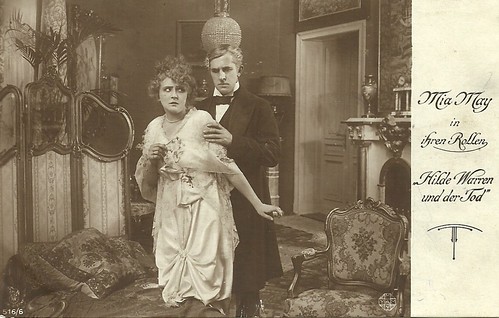
German postcard in the Film-Sterne series by Rotophot, no. 516/6. Photo: May Film. Mia May and Hans Mierendorff in Hilde Warren und der Tod/Hilde Warren and Death (Joe May, 1917), scripted by Fritz Lang.
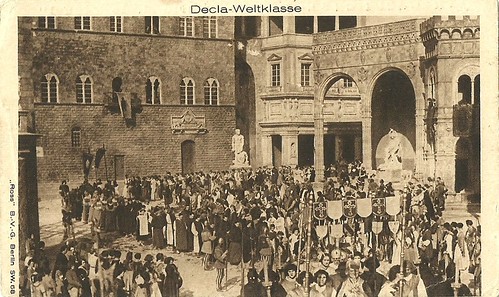
German postcard by Ross B.-V.-G., Berlin. Photo: Decla. Publicity still for the German historical drama Die Pest in Florenz/The Plague in Florence (Otto Rippert, 1919), script by Fritz Lang. The back of the card has a Spanish imprint.

German postcard by Ross Verlag , no. 3143. Photo Decla. Carl de Vogt and Lil Dagover in Die Spinnen, 1. Teil - Der Goldene See (Fritz Lang, 1919). Caption: Decla-Abenteuerklasse "Die Spinnen, 1. Abenteur "Der Goldene See". (Decla-adventure class "The Spiders", 1st adventure "The Golden Lake".) Sent by mail in 1924.

German postcard by Ross Verlag, Berlin, no. 678/4. Photo: Decla-Ufa-Film. Paul Richter in Die Nibelungen, part I (Fritz Lang, 1924). After slaying the dragon, Siegfried (Paul Richter) bathes in the dragon's blood, which will make him invulnerable. Incidentally, a leaf falls on his back, creating Siegfried's one weak spot (his Achilles heel). When the vain and arrogant Paul Richter refused to strip for this scene, Lang called in the not so pretty Rudolf Klein-Rogge (Etzel - Attila - in the film), who immediately undressed and played the scene, to the dismay of Richter, as people now would identify Klein-Rogge's behind as his.
In 1920, Fritz Lang met his future wife, the writer Thea von Harbou. She and Lang co-wrote all of his films from 1921 through 1933. In 1922 he became a German citizen. Dr. Mabuse, der Spieler/Dr. Mabuse the Gambler (1922) ran for over four hours in two parts in the original version and was the first in the Dr. Mabuse trilogy.
Then followed the five-hour Die Nibelungen/Die Nibelungen: Siegfried & Die Nibelungen: Kriemhild's Revenge (1924), starring Paul Richter and Margarete Schön.
His most famous film, the Fantasy Metropolis (1927) starring Brigitte Helm and Gustav Fröhlich, went far over budget and nearly destroyed Ufa which was then bought by right-wing businessman and politician Alfred Hugenberg.
Metropolis was a financial flop, as were his last silent films Spione/Spies (1928) with Willy Fritsch, and the Science Fiction film Frau im Mond/Woman in the Moon (1929) with Fritsch and Gerda Maurus, produced by Lang's own company.
In 1931, independent producer Seymour Nebenzahl hired Lang to direct M - Eine Stadt sucht einen Mörder/M (1931) for Nero-Film. Lang's first talking picture is considered by many film scholars to be a masterpiece of the early sound era. It is a disturbing story of a child murderer (Peter Lorre in his first starring role) who is hunted down and brought to rough justice by Berlin's criminal underworld. M remains a powerful work.
Wikipedia: "In the films of his German period, Lang produced a coherent oeuvre that established the characteristics later attributed to Film Noir, with its recurring themes of psychological conflict, paranoia, fate and moral ambiguity."
At the end of 1932, Lang started filming Das Testament des Dr. Mabuse/The Testament of Dr. Mabuse (1933), starring Rudolf Klein-Rogge. When Adolf Hitler came to power in 1933, the new regime soon banned the film as an incitement to public disorder. Das Testament des Dr. Mabuse is sometimes deemed an anti-Nazi film, as Lang had put phrases used by the Nazis into the mouth of the title character.
Lang was worried about the advent of the Nazi regime, partly because of his Jewish heritage, whereas his wife and co-screenwriter Thea von Harbou had started to sympathise with the Nazis in the early 1930s, and went on to join the NSDAP in 1940. They soon divorced.
According to Lang, propaganda minister Joseph Goebbels called him to his offices to inform him that Das Testament des Dr. Mabuse/The Testament of Dr. Mabuse was being banned but, nevertheless, he was so impressed by Lang's abilities as a filmmaker that he offered him the position of head of the Ufa. Lang did not accept the position and decided to leave for Paris.

German postcard by Ross Verlag, Berlin, no. 675/2, ca. 1924. Photo: Decla-Ufa-Film. Paul Richter in Die Nibelungen: Siegfried (Fritz Lang, 1924). Siegfried (Paul Richter) and Alberich in the fog meadow.
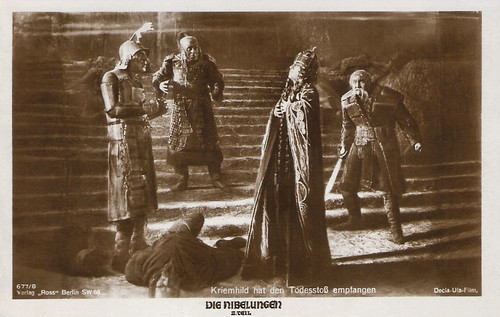
German postcard by Ross Verlag, Berlin, no. 677/8, 1919-1924. Photo: Decla-Ufa-Film. Publicity still for Die Nibelungen 2: Kriemhilds Rache/Die Nibelungen: Kriemhild's Revenge (Fritz Lang, 1924). Kriemhild (Margarete Schön) has gotten the deathblow. In the back, king Hetzel (Rudolf Klein-Rogge) looks in astonishment.

German postcard by Ross Verlag, no. 71/3. Photo: ParUfaMet / Ufa. Gustav Fröhlich in Metropolis (Fritz Lang, 1927).
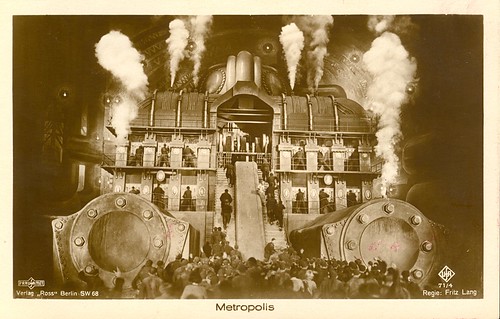
German postcard by Ross Verlag, Berlin, no. 71/4. Photo: Ufa / Parufamet. Publicity still for Metropolis (Fritz Lang, 1927). Collection: Amsterdam EYE Filmmuseum.

German postcard by Ross Verlag, Berlin, no. 71/12. Photo: Ufa / Parufamet. Brigitte Helm in Metropolis (Fritz Lang, 1927). Collection: Didier Hanson.

German postcard by Ross Verlag, Berlin, no. 7599/1, 1932-1933. Photo: Atelier Schneider, Berlin. Collection: Marlene Pilaete. Thea von Harbou.
In 1933, Fritz Lang divorced Thea von Harbou, who stayed behind in Berlin. In Paris, Lang filmed a version of Ferenc Molnár's Liliom (1933), starring Charles Boyer and Madeleine Ozeray.
In 1934, he moved to Hollywood, where he signed with MGM. His first American film was the crime drama Fury (1936), which starred Spencer Tracy as a man who is wrongly accused of a crime and nearly is killed when a lynch mob sets fire to the jail where he is awaiting trial.
From the beginning, Lang was struggling with restrictions in the United States. Thus, in Fury, he was not allowed to represent black victims in a lynching scenario or to criticise racism.
Lang became a naturalised citizen of the United States in 1939. He made twenty-three features in his 20-year American career, working in a variety of genres at every major studio in Hollywood, and occasionally producing his films as an independent.
Wikipedia: "His American films were often compared unfavorably to his earlier works by contemporary critics, but the restrained Expressionism of these films is now seen as integral to the emergence and evolution of American genre cinema, Film Noir in particular. His film Scarlet Street (1945) is considered a central film in the genre."
One of Lang's most famous Film Noirs is the police drama The Big Heat (1953), noted for its uncompromising brutality, especially for a scene in which Lee Marvin throws scalding coffee on Gloria Grahame's face.
As Lang's visual style simplified, in part due to the constraints of the Hollywood studio system, his worldview became increasingly pessimistic, culminating in the cold, geometric style of his last American films, While the City Sleeps (1956) and Beyond a Reasonable Doubt (1956).

German postcard by Ross Verlag, Berlin, no. 96/1. Photo: Fritz Lang Film. Rudolf Klein-Rogge in Spione/Spies (Fritz Lang, 1928). Collection: Didier Hanson.

German postcard by Ross Verlag, Berlin, no. 113/16. Photo: Ufa. Willy Fritsch and Gustav von Wangenheim in Frau im Mond/Woman in the Moon (Fritz Lang, 1929).

British postcard by Art Photo, no. 173. Sylvia Sidney and George Raft in You and Me (Fritz Lang, 1938).

Italian postcard by Garami, Milano, no. 154. Photo: RKO Radio Films. Joan Bennett in The Woman in the Window (Fritz Lang, 1944).
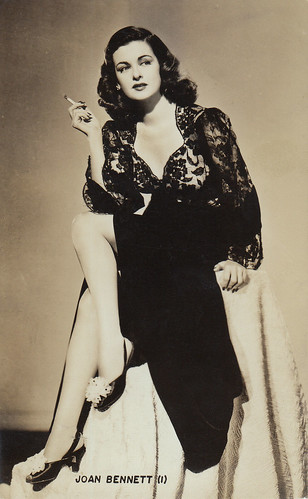
Vintage postcard. Joan Bennett in Scarlet Street (Fritz Lang, 1945). Collection: Marlene Pilaete.

West-German postcard by Kunst und Bild, Berlin / Crazy Cards, Berlin. Photo: RKO Radio Film. Marlene Dietrich in Rancho Notorious (Fritz Lang, 1952).
In the 1950s, Fritz Lang found it increasingly hard to get work, in part because the film industry was in economic decline and also because of Lang's long-standing reputation for being difficult to work with. His health also declined with age, and Lang contemplated retirement.
Then the German producer Artur Brauner expressed interest in remaking Das indische Grabmal/The Indian Tomb (1921) a silent film that Lang had developed but had ultimately been directed by Joe May. Lang returned to Germany to make his 'Indian Epic': Der Tiger von Eschnapur/The Tiger of Eschnapur (1959) and Das indische Grabmal/The Indian Tomb (1959) with Debra Paget, Paul Hubschmid, and Walter Reyer.
Following this production, Brauner was preparing a remake of Das Testament des Dr. Mabuse/The Testament of Dr. Mabuse (1933) when Lang approached him with the idea of adding a new original film to the series. The result was Die 1000 Augen des Dr. Mabuse/The Thousand Eyes of Dr. Mabuse (1960).
The success of the film led to a series of new Mabuse films, which were produced by Brauner, including the remake of The Testament of Dr. Mabuse. Lang did not direct any of the sequels.
He was approaching blindness during the production of The Thousand Eyes of Dr. Mabuse (1960) and it was his final project as director. In 1963, he appeared as himself in Jean-Luc Godard's film Le Mépris/Contempt (1963) with Brigitte Bardot and Michel Piccoli.
Fritz Lang died from a stroke in 1976 and was interred in the Forest Lawn – Hollywood Hills Cemetery in the Hollywood Hills of Los Angeles. He was 85. Langs was married three times: In 1919 he married Lisa Rosenthal, who died in 1921. He was married to Thea von Harbou, from 1922 till 1933, and to Lily Latté from 1971 till his death in 1976.
While his career had ended without fanfare, Lang's American and later German works were championed by the critics of the Cahiers du cinéma, such as François Truffaut and Jacques Rivette. In 1964, nearly blind, he was chosen to be president of the jury at the Cannes Film Festival.

West-German postcard by Kunst und Bild, Berlin / Crazy Cards, Berlin. Photo: RKO Radio Film. Marlene Dietrich in Rancho Notorious (Fritz Lang, 1952).

German postcard by Ufa/Film-Foto, Berlin-Tempelhof, no. FK 897. Photo: Columbia Film. Gloria Grahame in The Big Heat (Fritz Lang, 1953).

French postcard by Editions du Globe, no. 512. Photo: M.G.M. (Metro-Goldwyn-Mayer). Stewart Granger in Moonfleet (Fritz Lang, 1955).

West-German collectors card by Schumann Verlag, Berlin-Lichterfelde-Düd / Heinerle, Bamberg. Photo: Gloria. Debra Paget in Der Tiger von Eschnapur/The Tiger of Eschnapur (Fritz Lang, 1959).

West-German postcard by Kolibri-Verlag G.m.b.H., Minden/Westf., no. 486. Photo: CCC / Gloria-Film / Arthur Grimm. Walter Reyer in Der Tiger von Eschnapur (Fritz Lang, 1959).
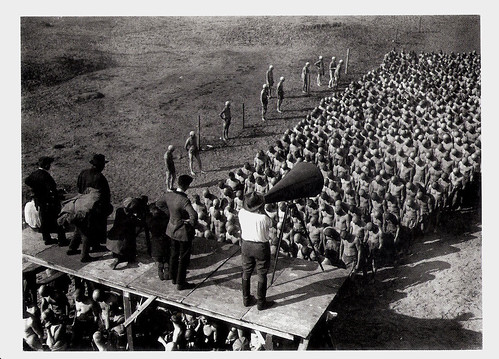
Swiss postcard by Musée de l'Elysée, Lausanne / News Productions, Baulmes, no. 55468. Photo: Horst von Harbou / Collection de la Cinemathèque Française, Paris. Caption: Fritz Lang during the shooting of Metropolis, 1926.
Sources: Wikipedia, and IMDb.

American postcard by Fotofolio, New York, N.Y., no. P124. Photo: Ufa / The Mansell Collection.

German photocard for the album Vom Werden deutscher Filmkunst. Teil I. Der stumme Film by Ross Verlag, picture no. 63. Photo: Decla-Film. Lil Dagover and Carl de Vogt in Die Spinnen/The Spiders (Fritz Lang, 1919-1920).

German collectors card by Ross Verlag in the series Vom Werden Deutscher Filmkunst - Der Stumme Film, picture no. 94, group 40. Photo: Ufa. Publicity still with Károly Huszár (left) and Rudolf Klein-Rogge (second from left) in Dr. Mabuse, der Spieler/Dr. Mabuse, King of Crime (Fritz Lang, 1922). Caption: Dr. Mabuse, who prints false money, lets the false notes sort by blind people who can not betray him.

German collectors card by Ross Verlag in the series Vom Werden Deutscher Filmkunst - Der Stumme Film, picture no. 143, group 43. Photo: Ufa. Heinrich George and Brigitte Helm in Metropolis (1926). Heinrich George plays the scene".

German collectors card by Ross Verlag in the series Vom Werden deutscher Filmkunst - Der Stumme Film, picture no. 124. Photo: Ufa. Rudolf Klein-Rogge and Gerda Maurus in Spione/Spies (Fritz Lang, 1928).

German collectors card by Ross Verlag in the series Vom Werden Deutscher Filmkunst - Der Stumme Film, picture no, 173, group 43. Photo: Ufa. Willy Fritsch in Spione/Spies (Fritz Lang, 1928).

German collectors card by Ross Verlag in the series Vom Werden Deutscher Filmkunst - Der Stumme Film, no. 169, Group 43. Photo: Ufa. Fritz Lang and Fritz Rasp at the set of Frau im Mond/Woman in the Moon (Fritz Lang, 1929).

German collectors card by Ross Verlag in the series Vom Werden Deutscher Filmkunst - Der Stumme Film, picture no. 138, group 40. Photo: Ufa. Willy Fritsch, Gerda Maurus and Gustl Stark-Gstettenbauer in Frau im Mond/Woman in the Moon (Fritz Lang, 1929).
Combining popular genres with Expressionist techniques
Friedrich Christian Anton 'Fritz' Lang was born in Vienna, Austria-Hungary (now Austria), as the second son of Anton Lang, an architect and construction company manager, and his wife Paula Lang born Schlesinger.
Paula was Jewish but converted to Catholicism when Lang was ten. His parents took their religion seriously and were dedicated to raising Fritz as a Catholic. Lang frequently had Catholic-influenced themes in his films.
After finishing school, Lang briefly attended the Technical University of Vienna, where he studied civil engineering and eventually switched to art. He left Vienna in 1910 in order to see the world, traveling throughout Europe and Africa, and later Asia and the Pacific area. In 1913, he studied painting in Paris.
At the outbreak of World War I, Lang returned to Vienna and volunteered for military service in the Austrian army. He fought in Russia and Romania, where he was wounded four times and lost sight in his right eye.
While recovering from his injuries and shell shock in 1916, he wrote some scenarios and ideas for films. These were filmed as Die Peitsche/The Whip (Adolf Gärtner, 1916), starring Ernst Reicher as the detective Stuart Webbs, and Hilde Warren und der Tod/Hilde Warren and Death (Joe May, 1917).
He was discharged from the army with the rank of lieutenant in 1918 and did some acting in the Viennese theatre circuit for a short time. Then he was hired by Erich Pommer as a writer at Decla Film in Berlin. Lang's writing stint there was brief, but resulted in Die Pest in Florenz/The Plague in Florence (Otto Rippert, 1919), based on the story 'The Masque of the Red Death' by Edgar Allan Poe.
Soon Lang started to work under Pommer as a director at the new German film studio Ufa, just as the Expressionist movement was building. In this first phase of his career, Lang alternated between such art films as Der Müde Tod/The Weary Death/Destiny (1921) and popular thrillers such as the two-parter Die Spinnen/The Spiders (1919). He combined popular genres with Expressionist techniques to create an unprecedented synthesis of popular entertainment with art cinema.

German postcard in the Film-Sterne series by Rotophot, no. 516/5. Mia May in Hilde Warren und der Tod/Hilde Warren and Death (Joe May, 1917), scripted by Fritz Lang.

German postcard in the Film-Sterne series by Rotophot, no. 516/6. Photo: May Film. Mia May and Hans Mierendorff in Hilde Warren und der Tod/Hilde Warren and Death (Joe May, 1917), scripted by Fritz Lang.

German postcard by Ross B.-V.-G., Berlin. Photo: Decla. Publicity still for the German historical drama Die Pest in Florenz/The Plague in Florence (Otto Rippert, 1919), script by Fritz Lang. The back of the card has a Spanish imprint.

German postcard by Ross Verlag , no. 3143. Photo Decla. Carl de Vogt and Lil Dagover in Die Spinnen, 1. Teil - Der Goldene See (Fritz Lang, 1919). Caption: Decla-Abenteuerklasse "Die Spinnen, 1. Abenteur "Der Goldene See". (Decla-adventure class "The Spiders", 1st adventure "The Golden Lake".) Sent by mail in 1924.

German postcard by Ross Verlag, Berlin, no. 678/4. Photo: Decla-Ufa-Film. Paul Richter in Die Nibelungen, part I (Fritz Lang, 1924). After slaying the dragon, Siegfried (Paul Richter) bathes in the dragon's blood, which will make him invulnerable. Incidentally, a leaf falls on his back, creating Siegfried's one weak spot (his Achilles heel). When the vain and arrogant Paul Richter refused to strip for this scene, Lang called in the not so pretty Rudolf Klein-Rogge (Etzel - Attila - in the film), who immediately undressed and played the scene, to the dismay of Richter, as people now would identify Klein-Rogge's behind as his.
At the offices of Joseph Goebbels
In 1920, Fritz Lang met his future wife, the writer Thea von Harbou. She and Lang co-wrote all of his films from 1921 through 1933. In 1922 he became a German citizen. Dr. Mabuse, der Spieler/Dr. Mabuse the Gambler (1922) ran for over four hours in two parts in the original version and was the first in the Dr. Mabuse trilogy.
Then followed the five-hour Die Nibelungen/Die Nibelungen: Siegfried & Die Nibelungen: Kriemhild's Revenge (1924), starring Paul Richter and Margarete Schön.
His most famous film, the Fantasy Metropolis (1927) starring Brigitte Helm and Gustav Fröhlich, went far over budget and nearly destroyed Ufa which was then bought by right-wing businessman and politician Alfred Hugenberg.
Metropolis was a financial flop, as were his last silent films Spione/Spies (1928) with Willy Fritsch, and the Science Fiction film Frau im Mond/Woman in the Moon (1929) with Fritsch and Gerda Maurus, produced by Lang's own company.
In 1931, independent producer Seymour Nebenzahl hired Lang to direct M - Eine Stadt sucht einen Mörder/M (1931) for Nero-Film. Lang's first talking picture is considered by many film scholars to be a masterpiece of the early sound era. It is a disturbing story of a child murderer (Peter Lorre in his first starring role) who is hunted down and brought to rough justice by Berlin's criminal underworld. M remains a powerful work.
Wikipedia: "In the films of his German period, Lang produced a coherent oeuvre that established the characteristics later attributed to Film Noir, with its recurring themes of psychological conflict, paranoia, fate and moral ambiguity."
At the end of 1932, Lang started filming Das Testament des Dr. Mabuse/The Testament of Dr. Mabuse (1933), starring Rudolf Klein-Rogge. When Adolf Hitler came to power in 1933, the new regime soon banned the film as an incitement to public disorder. Das Testament des Dr. Mabuse is sometimes deemed an anti-Nazi film, as Lang had put phrases used by the Nazis into the mouth of the title character.
Lang was worried about the advent of the Nazi regime, partly because of his Jewish heritage, whereas his wife and co-screenwriter Thea von Harbou had started to sympathise with the Nazis in the early 1930s, and went on to join the NSDAP in 1940. They soon divorced.
According to Lang, propaganda minister Joseph Goebbels called him to his offices to inform him that Das Testament des Dr. Mabuse/The Testament of Dr. Mabuse was being banned but, nevertheless, he was so impressed by Lang's abilities as a filmmaker that he offered him the position of head of the Ufa. Lang did not accept the position and decided to leave for Paris.

German postcard by Ross Verlag, Berlin, no. 675/2, ca. 1924. Photo: Decla-Ufa-Film. Paul Richter in Die Nibelungen: Siegfried (Fritz Lang, 1924). Siegfried (Paul Richter) and Alberich in the fog meadow.

German postcard by Ross Verlag, Berlin, no. 677/8, 1919-1924. Photo: Decla-Ufa-Film. Publicity still for Die Nibelungen 2: Kriemhilds Rache/Die Nibelungen: Kriemhild's Revenge (Fritz Lang, 1924). Kriemhild (Margarete Schön) has gotten the deathblow. In the back, king Hetzel (Rudolf Klein-Rogge) looks in astonishment.

German postcard by Ross Verlag, no. 71/3. Photo: ParUfaMet / Ufa. Gustav Fröhlich in Metropolis (Fritz Lang, 1927).

German postcard by Ross Verlag, Berlin, no. 71/4. Photo: Ufa / Parufamet. Publicity still for Metropolis (Fritz Lang, 1927). Collection: Amsterdam EYE Filmmuseum.

German postcard by Ross Verlag, Berlin, no. 71/12. Photo: Ufa / Parufamet. Brigitte Helm in Metropolis (Fritz Lang, 1927). Collection: Didier Hanson.

German postcard by Ross Verlag, Berlin, no. 7599/1, 1932-1933. Photo: Atelier Schneider, Berlin. Collection: Marlene Pilaete. Thea von Harbou.
Struggling with restrictions in the USA
In 1933, Fritz Lang divorced Thea von Harbou, who stayed behind in Berlin. In Paris, Lang filmed a version of Ferenc Molnár's Liliom (1933), starring Charles Boyer and Madeleine Ozeray.
In 1934, he moved to Hollywood, where he signed with MGM. His first American film was the crime drama Fury (1936), which starred Spencer Tracy as a man who is wrongly accused of a crime and nearly is killed when a lynch mob sets fire to the jail where he is awaiting trial.
From the beginning, Lang was struggling with restrictions in the United States. Thus, in Fury, he was not allowed to represent black victims in a lynching scenario or to criticise racism.
Lang became a naturalised citizen of the United States in 1939. He made twenty-three features in his 20-year American career, working in a variety of genres at every major studio in Hollywood, and occasionally producing his films as an independent.
Wikipedia: "His American films were often compared unfavorably to his earlier works by contemporary critics, but the restrained Expressionism of these films is now seen as integral to the emergence and evolution of American genre cinema, Film Noir in particular. His film Scarlet Street (1945) is considered a central film in the genre."
One of Lang's most famous Film Noirs is the police drama The Big Heat (1953), noted for its uncompromising brutality, especially for a scene in which Lee Marvin throws scalding coffee on Gloria Grahame's face.
As Lang's visual style simplified, in part due to the constraints of the Hollywood studio system, his worldview became increasingly pessimistic, culminating in the cold, geometric style of his last American films, While the City Sleeps (1956) and Beyond a Reasonable Doubt (1956).

German postcard by Ross Verlag, Berlin, no. 96/1. Photo: Fritz Lang Film. Rudolf Klein-Rogge in Spione/Spies (Fritz Lang, 1928). Collection: Didier Hanson.

German postcard by Ross Verlag, Berlin, no. 113/16. Photo: Ufa. Willy Fritsch and Gustav von Wangenheim in Frau im Mond/Woman in the Moon (Fritz Lang, 1929).

British postcard by Art Photo, no. 173. Sylvia Sidney and George Raft in You and Me (Fritz Lang, 1938).

Italian postcard by Garami, Milano, no. 154. Photo: RKO Radio Films. Joan Bennett in The Woman in the Window (Fritz Lang, 1944).

Vintage postcard. Joan Bennett in Scarlet Street (Fritz Lang, 1945). Collection: Marlene Pilaete.

West-German postcard by Kunst und Bild, Berlin / Crazy Cards, Berlin. Photo: RKO Radio Film. Marlene Dietrich in Rancho Notorious (Fritz Lang, 1952).
A career without fanfare
In the 1950s, Fritz Lang found it increasingly hard to get work, in part because the film industry was in economic decline and also because of Lang's long-standing reputation for being difficult to work with. His health also declined with age, and Lang contemplated retirement.
Then the German producer Artur Brauner expressed interest in remaking Das indische Grabmal/The Indian Tomb (1921) a silent film that Lang had developed but had ultimately been directed by Joe May. Lang returned to Germany to make his 'Indian Epic': Der Tiger von Eschnapur/The Tiger of Eschnapur (1959) and Das indische Grabmal/The Indian Tomb (1959) with Debra Paget, Paul Hubschmid, and Walter Reyer.
Following this production, Brauner was preparing a remake of Das Testament des Dr. Mabuse/The Testament of Dr. Mabuse (1933) when Lang approached him with the idea of adding a new original film to the series. The result was Die 1000 Augen des Dr. Mabuse/The Thousand Eyes of Dr. Mabuse (1960).
The success of the film led to a series of new Mabuse films, which were produced by Brauner, including the remake of The Testament of Dr. Mabuse. Lang did not direct any of the sequels.
He was approaching blindness during the production of The Thousand Eyes of Dr. Mabuse (1960) and it was his final project as director. In 1963, he appeared as himself in Jean-Luc Godard's film Le Mépris/Contempt (1963) with Brigitte Bardot and Michel Piccoli.
Fritz Lang died from a stroke in 1976 and was interred in the Forest Lawn – Hollywood Hills Cemetery in the Hollywood Hills of Los Angeles. He was 85. Langs was married three times: In 1919 he married Lisa Rosenthal, who died in 1921. He was married to Thea von Harbou, from 1922 till 1933, and to Lily Latté from 1971 till his death in 1976.
While his career had ended without fanfare, Lang's American and later German works were championed by the critics of the Cahiers du cinéma, such as François Truffaut and Jacques Rivette. In 1964, nearly blind, he was chosen to be president of the jury at the Cannes Film Festival.

West-German postcard by Kunst und Bild, Berlin / Crazy Cards, Berlin. Photo: RKO Radio Film. Marlene Dietrich in Rancho Notorious (Fritz Lang, 1952).

German postcard by Ufa/Film-Foto, Berlin-Tempelhof, no. FK 897. Photo: Columbia Film. Gloria Grahame in The Big Heat (Fritz Lang, 1953).

French postcard by Editions du Globe, no. 512. Photo: M.G.M. (Metro-Goldwyn-Mayer). Stewart Granger in Moonfleet (Fritz Lang, 1955).

West-German collectors card by Schumann Verlag, Berlin-Lichterfelde-Düd / Heinerle, Bamberg. Photo: Gloria. Debra Paget in Der Tiger von Eschnapur/The Tiger of Eschnapur (Fritz Lang, 1959).

West-German postcard by Kolibri-Verlag G.m.b.H., Minden/Westf., no. 486. Photo: CCC / Gloria-Film / Arthur Grimm. Walter Reyer in Der Tiger von Eschnapur (Fritz Lang, 1959).

Swiss postcard by Musée de l'Elysée, Lausanne / News Productions, Baulmes, no. 55468. Photo: Horst von Harbou / Collection de la Cinemathèque Française, Paris. Caption: Fritz Lang during the shooting of Metropolis, 1926.
Sources: Wikipedia, and IMDb.
No comments:
Post a Comment